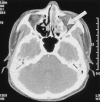Mediastinal single nodal relapse of a nasal NK/T cell lymphoma
- PMID: 17939339
- PMCID: PMC2687701
- DOI: 10.3904/kjim.2007.22.3.201
Mediastinal single nodal relapse of a nasal NK/T cell lymphoma
Abstract
A nasal NK/T cell lymphoma is a very aggressive form of lymphoma. Patterns of relapse after treatment have not been systematically evaluated, and mediastinal nodal relapse at a primary site has never been documented. We describe here a 40-year old man who presented with a nasal obstruction caused by a protruding mass that was identified as a nasal NK/T cell lymphoma. The initial work-up, including chest and abdominopelvic computed tomography (CT) and positron emission tomography (PET), showed no regional or distant metastasis. A CT scan performed following three cycles of chemotherapy with cyclophosphamide, doxorubicin, vincristine, and prednisolone (CHOP) showed that the mass had nearly disappeared. Radiation therapy undertaken following chemotherapy was given to the primary site. However, PET performed following radiotherapy revealed a single mediastinal lymphadenopathy, with no evidence of residual tumor in the nasal cavity. A biopsy using video-assisted thoracoscopy (VATS) showed the presence of a recurrent NK/T cell lymphoma with an immunophenotype identical to that of the primary nasal lymphoma. An additional three cycles of CHOP chemotherapy were administered, and the patient remains alive, with no evidence of disease 30 months after the initial relapse. These findings indicate that early detection with PET and prompt surgical excision with the use of VATS can lead to successful treatment of a relapsed nasal NK/T cell lymphoma.
Figures




Similar articles
-
[Nasal NK/T-cell lymphoma: about two rare cases].Pan Afr Med J. 2018 Jun 19;30:141. doi: 10.11604/pamj.2018.30.141.7721. eCollection 2018. Pan Afr Med J. 2018. PMID: 30374387 Free PMC article. French.
-
Extranodal NK/T-cell lymphoma, nasal type: report of 15 cases.Eur Ann Otorhinolaryngol Head Neck Dis. 2012 Jun;129(3):141-7. doi: 10.1016/j.anorl.2011.08.004. Epub 2012 Feb 7. Eur Ann Otorhinolaryngol Head Neck Dis. 2012. PMID: 22321911
-
Successful treatment of nasal T-cell lymphoma with a combination of local irradiation and high-dose chemotherapy.Int J Hematol. 2002 Feb;75(2):195-200. doi: 10.1007/BF02982028. Int J Hematol. 2002. PMID: 11939269
-
[Treatment of localized nasal NK/T-cell lymphoma].Rinsho Ketsueki. 2008 Aug;49(8):553-8. Rinsho Ketsueki. 2008. PMID: 18800601 Review. Japanese. No abstract available.
-
[Isolated plasmablastic lymphoma of nasal mucosa in an immunocompetent patient achieving complete remission after multimodal treatment: about an African patient and literature review].Pan Afr Med J. 2020 Sep 5;37:22. doi: 10.11604/pamj.2020.37.22.21352. eCollection 2020. Pan Afr Med J. 2020. PMID: 33062124 Free PMC article. Review. French.
References
-
- Cheung MM, Chan JK, Lau WH, Foo W, Chan PT, Ng CS, Ngan RK. Primary non-Hodgkin's lymphoma of the nose and nasopharynx: clinical features, tumor immunophenotype, and treatment outcome in 113 patients. J Clin Oncol. 1998;16:70–77. - PubMed
-
- Ooi GC, Chim CS, Liang R, Tsang KW, Kwong YL. Nasal T-cell/natural killer cell lymphoma: CT and MR imaging features of a new clinicopathologic entity. AJR Am J Roentgenol. 2000;174:1141–1145. - PubMed
-
- Chan JK, Jaffe ES, Ralfkiaer E. Extranodal NK/T cell lymphoma, nasal type. In: Jaffe ES, Harris NL, Stein H, editors. Pathology and genetics tumors of hematopoietic and lymphoid tissue. Lyon: IARC Press; 2001. pp. 204–207.
-
- Jaffe ES, Chan JK, Su IJ, Frizzera G, Mori S, Feller AC, Ho FC. Report of the Workshop on Nasal and Related Extranodal Angiocentric T/Natural Killer Cell Lymphomas: definitions, differential diagnosis and epidemiology. Am J Surg Pathol. 1996;20:103–111. - PubMed
-
- Ferry JA, Skar J, Zukerberg LR, Harris NL. Nasal lymphoma: a clinicopathologic study with immunophenotypic and genotypic analysis. Am J Surg Pathol. 1991;15:268–279. - PubMed
Publication types
MeSH terms
Substances
Supplementary concepts
LinkOut - more resources
Full Text Sources
Medical
Research Materials
